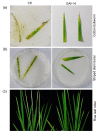Generation of insect-resistant and glyphosate-tolerant rice by introduction of a T-DNA containing two Bt insecticidal genes and an EPSPS gene
- PMID: 26465130
- PMCID: PMC4609534
- DOI: 10.1631/jzus.B1500056
Generation of insect-resistant and glyphosate-tolerant rice by introduction of a T-DNA containing two Bt insecticidal genes and an EPSPS gene
Abstract
Insect resistance and glyphosate tolerance have been two of the most important traits in the genetic improvement of various crops. In this study, two Bacillus thuringiensis (Bt) insecticidal genes, Cry1Ac and Cry1Ig, and a modified glyphosate-tolerant 5-enolpyruvylshikimate-3-phosphate synthase (EPSPS) gene (G10) were combined into a single transferred DNA (T-DNA) fragment and introduced into rice by Agrobacterium-mediated transformation. A transgenic line with single-copy T-DNA insertion named GAI-14 was found to be highly resistant to striped stem borer and rice leaf roller, and tolerant to glyphosate. Analysis of T-DNA border sequence suggested that the transgenes were inserted at the chromosome 3 and appeared to have not interrupted any known or putative genes. A field trial observed no significant difference in the basic agronomic traits between GAI-14 and the recipient rice.
Keywords: Bt gene stacking; Bt resistance management; EPSPS; Transgenic rice.
Conflict of interest statement
All institutional and national guidelines for the care and use of laboratory animals were followed.
Figures






Similar articles
-
Molecular characterization and efficacy evaluation of a transgenic corn event for insect resistance and glyphosate tolerance.J Zhejiang Univ Sci B. 2018 Aug.;19(8):610-619. doi: 10.1631/jzus.B1700345. J Zhejiang Univ Sci B. 2018. PMID: 30070084 Free PMC article.
-
Development of stem borer resistant transgenic parental lines involved in the production of hybrid rice.J Biotechnol. 2004 Jul 15;111(2):131-41. doi: 10.1016/j.jbiotec.2004.04.004. J Biotechnol. 2004. PMID: 15219400
-
Acquiring transgenic tobacco plants with insect resistance and glyphosate tolerance by fusion gene transformation.Plant Cell Rep. 2012 Oct;31(10):1877-87. doi: 10.1007/s00299-012-1301-5. Epub 2012 Jul 10. Plant Cell Rep. 2012. PMID: 22777591
-
Overview on current status of biotechnological interventions on yellow stem borer Scirpophaga incertulas (Lepidoptera: Crambidae) resistance in rice.Biotechnol Adv. 2010 Jan-Feb;28(1):70-81. doi: 10.1016/j.biotechadv.2009.09.003. Biotechnol Adv. 2010. PMID: 19811767 Review.
-
Bacillus thuringiensis (Bt) transgenic crop: an environment friendly insect-pest management strategy.J Environ Biol. 2008 Sep;29(5):641-53. J Environ Biol. 2008. PMID: 19295059 Review.
Cited by
-
Transgene Stacking as Effective Tool for Enhanced Disease Resistance in Plants.Mol Biotechnol. 2020 Jan;62(1):1-7. doi: 10.1007/s12033-019-00213-2. Mol Biotechnol. 2020. PMID: 31538309 Review.
-
Stacking Multiple Genes Improves Resistance to Chilo suppressalis, Magnaporthe oryzae, and Nilaparvata lugens in Transgenic Rice.Genes (Basel). 2023 May 12;14(5):1070. doi: 10.3390/genes14051070. Genes (Basel). 2023. PMID: 37239430 Free PMC article.
-
The application of gene splitting technique for controlling transgene flow in rice.Transgenic Res. 2020 Feb;29(1):69-80. doi: 10.1007/s11248-019-00178-7. Epub 2019 Oct 25. Transgenic Res. 2020. PMID: 31654191
References
Publication types
MeSH terms
Substances
LinkOut - more resources
Full Text Sources
Other Literature Sources

